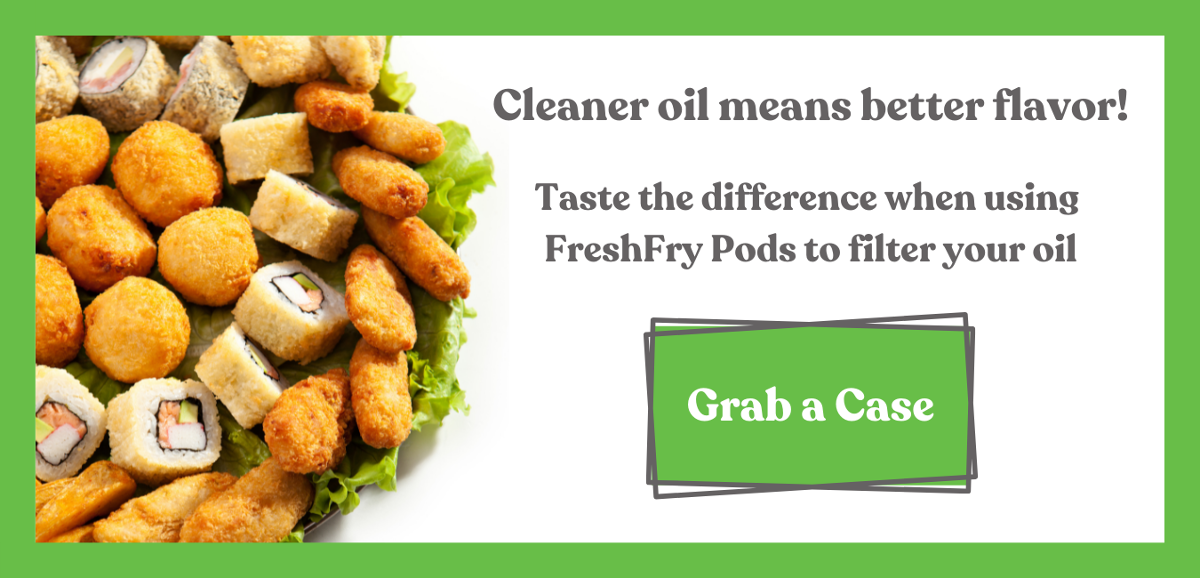Here are the Best Options for Filtering Fryer Oil
Before we review your options for filtering fryer oil, let’s first discuss WHY you should be doing it... Frying oil is expensive. Besides your people and the food itself, frying oil is the next highest expense in most restaurants, so it’s important to get the most out of it.
The Deep Fry Filter You Need to Know About >>
We use this ratio: “pound of food per pound of oil,” and the goal is to cook/serve the most delicious fried food with the least amount of oil.
Oil Degradation: The Six Enemies of Oil
In order to increase this ratio of food to oil, it’s important to understand the “6 Enemies of Oil” and how they speed up the oil degradation process.
Oxygen
-
Oil is a food and like most foods, it goes bad when opened. Try to keep your vats covered when not in use
Salt
-
When added to food it tastes great, but salt will break down oil life. Don’t salt foods before frying or over an open vat.
Soap
-
When cleaning the inside of your fryer, avoid soap. The soap residue will react with oil and create off-tasting flavors, smoking and foaming.
Heat
-
Set your fryers to the recommended cooking temperature and check that it’s correct. Turn your fryers off at night, as well as any unneeded fryers during the day.
Carbon
-
Crumbs will build up in your fryer over time. Try to skim out anything you see before it burns. Filter your oil regularly to remove other particles you can’t skim. Remove any carbon buildup inside your fryers (usually this builds up at the oil surface line).
Water
-
The saying is true: Oil and water don’t mix! There is plenty of water inside food that will be expelled as steam when cooking, but avoid what you can along the way. Some foods will have ice or excess water on them so shake it off before cooking.
Oil Filtration Options
Now to the filtering! There are several ways to remove contaminants from your oil, depending on your desired level of complexity and investment.
Skimming
The simplest form of filtering is simply skimming out crumbs (shown below). With this method it’s difficult to be thorough and get to the crumbs at the bottom.

Oil Skimming simply removes crumbs.
Cone Filter
Another cost effective way to filter is with a cone (shown below). Empty the oil through the cone filter into a properly sized stock pot and return the oil to your fryer.

Cone Filtering into a stock pot.
Filtration Machine
The last and most expensive way to filter frying oil is with a machine like the one shown below. With this setup, you must source the correct size filter paper envelope that is then placed inside the machine. The oil is emptied into the machine and circulated through the filter before going back into the fryer using the included wand.

Fry Oil Filtering Machine
FreshFry Pods
Sure you can remove the crumbs, but what about water and other impurities? FreshFry Pods are designed to work with the oil filtration system of your choice to keep the oil replenished.
Combat the Six Enemies of Oil with FreshFry Pods
FreshFry Pods work overnight by capturing and removing the impurities that degrade your oil and make it smoke, look dark, and taste bitter. They remove water, free fatty acids (FFA), polymers (the things that make the build up around the fryer-it's actually plastic!), and trace metals (ex. iron that comes from chicken).
Change your oil less often
Imagine if you didn’t need to worry about these messy oil filtration processes as often. FreshFry Pods extend the life of your good oil, so you can get back to what matters: creating incredible food!






